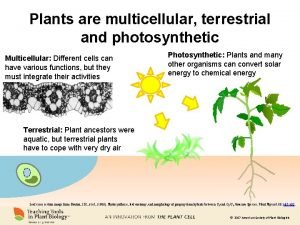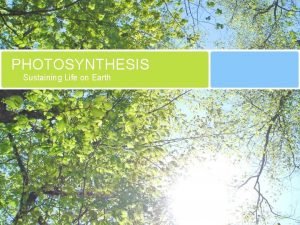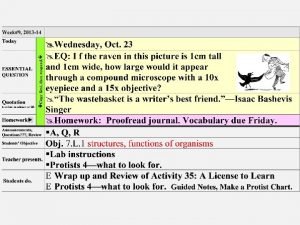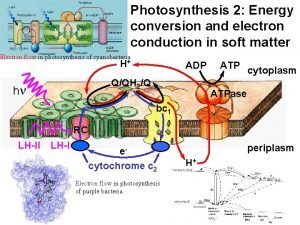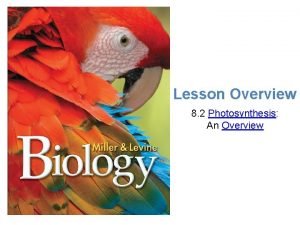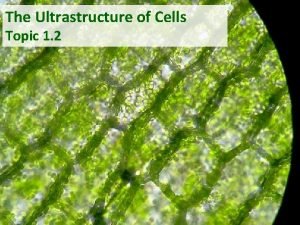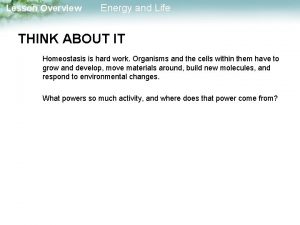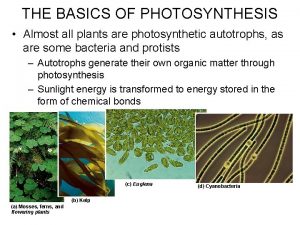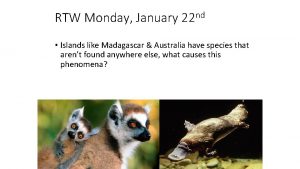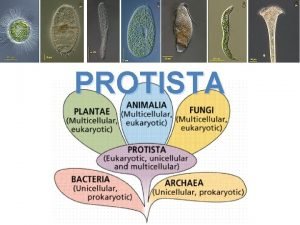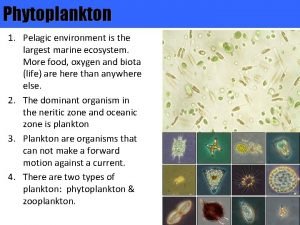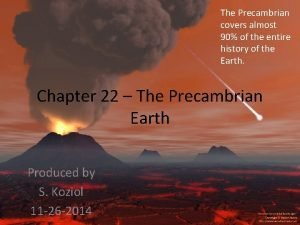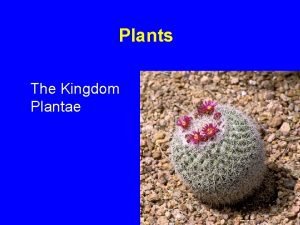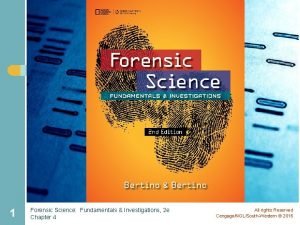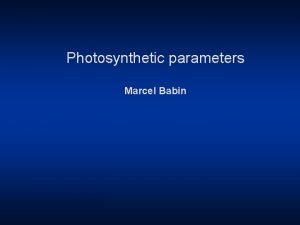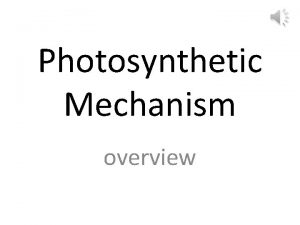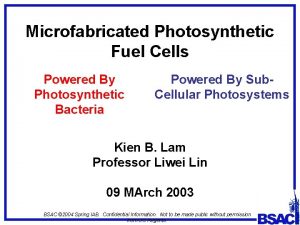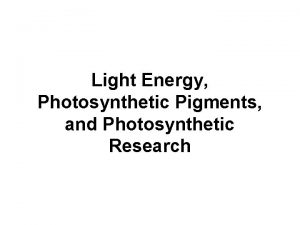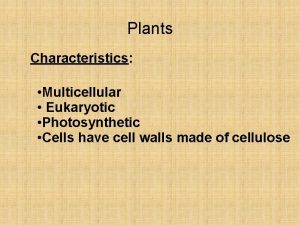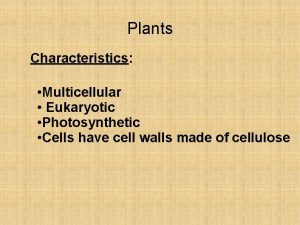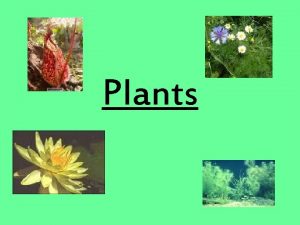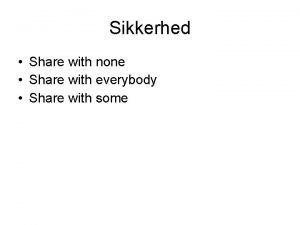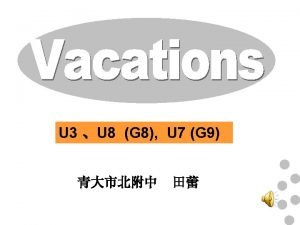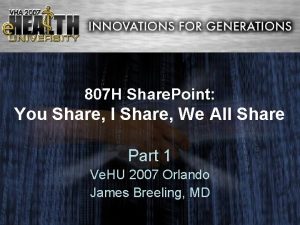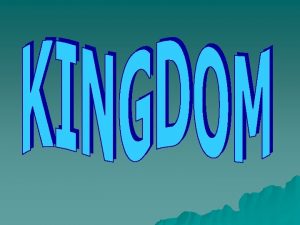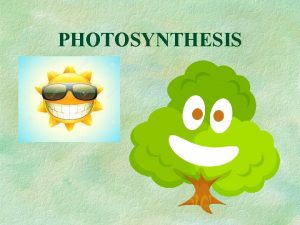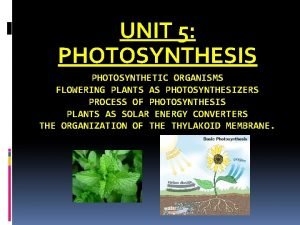Plants Module 13 Plants share common characteristics Photosynthetic






















- Slides: 22

Plants Module 13

Plants share common characteristics • Photosynthetic autotrophs (use the sun’s energy to make sugar/glucose) • Multicellular (made of eukaryotic cells) • Producers (are the base of the food web in ecosystems)

Plant Classification 2 major categories: Having or not having Specialized Tissues 1. Non-vascular (no tubes / vessels) 2. Vascular (tubes/vessels for transport)

Plant Classification Vascular plants are further divided 1. Seedless (use spores for reproduction) Ex. Fern 2. Seeded (use seeds for reproduction) Ex. Sunflower

Plant Classification Seed plants are further divided 1. Gymnosperms (seeds in cones) 2. Angiosperms (seeds in fruits that develop from flowers)

Complete the STERNGERR Plant Sticky Notes Foldable • NOTE: you will need 4 sticky notes for plant Reproduction: 1. Asexual Reproduction 2. Spores 3. Seeds 4. Flowers 5. Make sure to complete the foldable as directed by your teacher.

STERNGRR Processes Synthesis: • Photosynthesis used to make food • Protein synthesis Chloroplasts

STERNGRR Processes Transport: • Non-vascular plants use osmosis • Vascular plants have xylem to transport water and phloem to transport food (in vascular bundle / vein) FOOD WATER

STERNGRR Processes Excretion: • Tiny openings in the leaf called stomata allow gas exchange; regulated by guard cells • Wastes may be stored in leaves that fall off in autumn

STERNGRR Processes Respiration: • Use oxygen and sugar to produce ATP for energy

STERNGRR Processes Nutrition: • Sugar produced in photosynthesis is used for cellular respiration or stored for later use.

STERNGRR Processes Growth and Development: • Seeds germinate to start the process of development into a new plant

STERNGRR Processes Asexual Reproduction: • Occurs through the process of vegetative propagation

STERNGRR Processes Spores: • Produced by non-vascular and seedless vascular plants for reproduction

STERNGRR Processes Seeds: • Found in cones in gymnosperms • Found in fruits that develop from flowers in angiosperms

STERNGRR Processes Flowers: • Male parts Stamen - anther and filament • Female parts Pistil – stigma, style and ovary

STERNGRR Processes Flowers: • Pollination occurs • Fertilization occurs when pollen (male) when a sperm (in is transferred to the pollen) meets egg stigma (female) (in ovary)

STERNGRR Processes Regulation • Hormones – regulate growth and control responses to stimuli (Ex. auxin, cytokinen, ethylene) • Tropisms – growth responses to external stimuli

Plant Adaptations - Leaf Cuticle Carnivorous Increased Surface area To get as much sunlight Protection

Plant Adaptations - Stem Tuber: store energy Tendrils to attach to other plants and receive light. Succulent: store as much water as they can. Fat leaves. Runners: have enough space and receive enough light.

Plant Adaptations - Root Taproot Fibrous Root hairs

Explain all types of Plant Adaptations: 1. Why some plants have large leaves? 2. Why some plants have leaves like needles? 3. Why some plants have fat (Succulent) leaves? 4. Why some plants have Tendrils and leaves? 5. Why some plants have tubers and different types of roots? 6. How do vascular and non vascular plants transport water?
 Photosynthetic, multicellular, and terrestrial?
Photosynthetic, multicellular, and terrestrial? What is a photosynthetic organism
What is a photosynthetic organism Find one
Find one Photosynthetic apparatus
Photosynthetic apparatus Chloroplast contain saclike photosynthetic membranes called
Chloroplast contain saclike photosynthetic membranes called Cell
Cell Ground tissue
Ground tissue Photosynthetic cells
Photosynthetic cells Photosynthetic autotroph
Photosynthetic autotroph Which kingdoms have photosynthetic organisms? *
Which kingdoms have photosynthetic organisms? * Protista
Protista Photosynthetic phytoplankton
Photosynthetic phytoplankton Mat or mound composed of billions of cyanobacteria
Mat or mound composed of billions of cyanobacteria Plantae common characteristics
Plantae common characteristics What common belief did all progressives share?
What common belief did all progressives share? All plant fibers share the common polymer that is
All plant fibers share the common polymer that is C device module module 1
C device module module 1 Greatest common factor of 20 and 36
Greatest common factor of 20 and 36 Common anode and common cathode
Common anode and common cathode Prime factors of 72
Prime factors of 72 Lowest common factor
Lowest common factor Greatest common factor and least common multiple
Greatest common factor and least common multiple Multiples of 9 and 21
Multiples of 9 and 21
